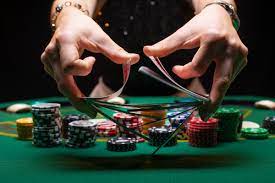Slot games have become one of the most iconic forms of entertainment in the kebun toto world of gambling, from the flashing lights and immersive sound effects of traditional land-based casinos to the virtual wonders of online platforms. While most people are familiar with the basic mechanics of a slot machine—a lever or button, spinning reels, and the thrill of a winning combination—the fascinating world behind slot games is far more complex than meets the eye. Let’s delve into the art, science, and excitement of slots, and explore what makes them so captivating to millions of players worldwide.
The Origins of Slot Machines
The history of slot machines traces back to the late 19th century. The first mechanical slot machine, known as the Liberty Bell, was created in 1895 by Charles Fey, a mechanic from San Francisco. This innovative machine had three spinning reels, each adorned with five symbols—diamonds, spades, hearts, horseshoes, and a cracked Liberty Bell. The aim was simple: line up the same symbols on a payline to win a prize. This machine laid the foundation for the slot games that would evolve over the decades into the modern versions that fill casinos today.
Initially, slot machines were purely mechanical, powered by intricate gears and springs. However, as technology advanced, these machines transitioned to electronic systems, leading to the creation of video slots and the introduction of randomized number generators (RNGs), which ensured fairness and unpredictability in every spin.
The Mechanics of Modern Slot Games
While the traditional mechanics of a slot machine have evolved, the concept remains largely unchanged. Modern slot games can be found in both land-based casinos and online platforms, but they all share common components.
- Reels: The spinning wheels that display various symbols. Today, most slots have five reels, though there are also machines with three, seven, or even more reels.
- Symbols: These represent the icons that appear on the reels, such as fruits, animals, numbers, or thematic designs like ancient civilizations or movies. Some symbols have special functions, such as wilds, which can substitute for others to complete winning combinations, and scatters, which trigger bonus features.
- Paylines: The paths across the reels where a winning combination must occur. In the past, slots had a single payline, but modern games can feature hundreds or even thousands of ways to win, thanks to cluster pay systems and other innovative features.
- Bonus Features: The introduction of interactive bonus rounds has added a whole new level of excitement to slots. These can include free spins, pick-a-prize games, multipliers, and jackpots. Bonus features often tie into the game’s theme and can make a simple slot experience far more engaging.
- Random Number Generator (RNG): This algorithm is at the heart of every modern slot game. It ensures that every spin is independent of the last, providing fairness and randomness in the outcome. RNGs are rigorously tested and certified by gaming authorities to ensure that results are unpredictable and unbiased.
The Psychology Behind Slot Games
One of the primary reasons for the immense popularity of slot games lies in the psychology behind them. Slot machines are designed to evoke powerful emotional responses through a combination of sensory cues—visuals, sound, and haptic feedback. These elements are tailored to trigger a sense of anticipation and excitement, making each spin feel like a mini-event.
Near Misses are one psychological trick used by slot developers to keep players engaged. A near miss occurs when the symbols on the reels almost line up for a winning combination. For example, seeing two identical symbols on adjacent reels and then a third symbol just one position away can leave a player feeling “so close” to a win. This sensation boosts engagement and encourages players to keep playing, despite not actually winning.
The concept of variable rewards also plays a role in keeping players hooked. Instead of offering consistent payouts, slots often provide random wins, leading to a phenomenon known as the “illusion of control.” This variable nature of rewards makes the experience more exciting, even though the outcomes are entirely based on chance.
The Rise of Online Slots
The shift from land-based casinos to online platforms has been one of the most significant changes in the slot game industry. Online casinos have brought slot games to a global audience, allowing players to spin the reels from the comfort of their own homes or on the go, thanks to mobile compatibility.
Online slots come in a vast array of themes, with developers creating immersive experiences that take players to new worlds. Whether it’s exploring the wilds of Africa, diving into the depths of the ocean, or experiencing the thrills of a superhero universe, the thematic creativity of online slots has skyrocketed. Some games are even based on popular films and TV shows, featuring beloved characters and scenes that immerse players even further into the gaming experience.
Furthermore, the progressive jackpot has been a game-changer in the online slot scene. Progressive jackpots accumulate a portion of every player’s bet until one lucky player hits the grand prize, sometimes reaching millions of dollars. This potential for life-changing winnings has added a layer of excitement that traditional slots could not match.
Mobile Slots: The Future of Gambling
With the advent of smartphones, mobile slots have taken the industry by storm. Players can now enjoy their favorite slot games wherever they are, whether it’s during a commute or on a vacation. Mobile platforms offer the same immersive experiences as their desktop counterparts, with developers optimizing graphics and gameplay to suit smaller screens.
In addition to traditional video slots, new forms of mobile games such as live slots—where players interact with real human dealers—have started to emerge, bringing a social element to the slot experience.
The Future of Slot Games
The future of slot games seems brighter than ever. With advancements in technology, we can expect even more immersive experiences, incorporating virtual reality (VR), augmented reality (AR), and more sophisticated artificial intelligence (AI) into the design of slot machines. VR and AR have the potential to create fully immersive, 3D worlds for players to explore, making slot games even more thrilling and engaging.
Moreover, innovations in gamification could add a new layer of interaction and rewards. For instance, players may soon be able to unlock achievements, level up, and earn bonuses by completing challenges within a game, making the experience even more dynamic and personal.
Conclusion
Slot games have evolved from humble mechanical machines to complex, interactive experiences that offer a blend of chance, skill, and entertainment. Whether in a traditional casino or on an online platform, the excitement of the spin remains as captivating as ever. The blend of technology, psychology, and design ensures that slot games will continue to entertain millions for years to come, with innovations on the horizon keeping the industry fresh and exciting.




